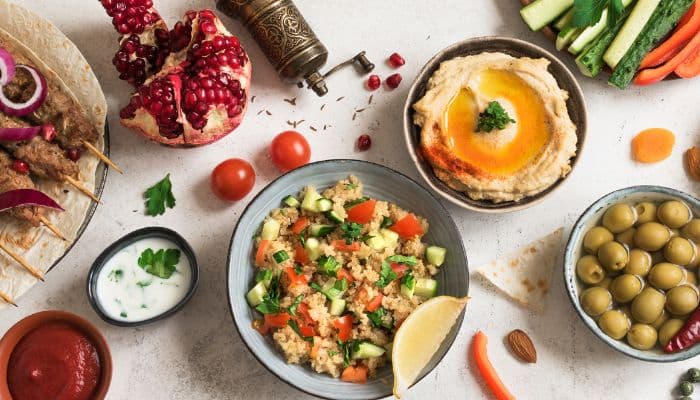Food is maybe the only universal thing that really has the power to bring people together.

Both the Jews of the Iberian Peninsula and the Jewish communities already present in Morocco, Tunisia, Algeria, Bulgaria, Turkey, Syria, Egypt, Italy, and Greece, into which they immigrated, modified regional foods to fit the kosher kitchen’s restrictions.
These regional cuisines, in all their diversity, have come to reflect the collection of culinary traditions collectively known as Sephardi cuisine since the foundation of a Jewish state and the confluence of Jews from all over the world in Israel.
Some of the Sephardic Jews who fled the Inquisition in the 15th century lived in Recife, Brazil, where their food was inspired by new regional ingredients such molasses, rum, sugar, vanilla, chocolate, bell peppers, corn, tomatoes, kidney beans, string beans, and turkey.
Twenty-three Sephardic Jews who had just arrived in New Amsterdam (modern-day New York) in 1654 brought this cuisine to the early colonies of the United States. This branch of Sephardic cuisine greatly influenced the early Jewish cuisine of America.
A large number of the recipes were tied to the observance of customary holidays and stayed faithful to their roots. These included foods like stews, fish fried in olive oil, beef and bean stews, puddings with almonds, and egg custards. The Jewish Cookery Book by Esther Levy, which was originally printed in America in 1871 and contains many of the customary recipes, was the first kosher cookbook.
Salads, filled vegetables and vine leaves, olive oil, lentils, fresh and dried fruits, herbs, almonds, and chickpeas are all staples of Sephardi cuisine. Ground beef or lamb are frequently used in meat recipes.
Many soups and sauces include freshly squeezed lemon juice. Dried fruits including raisins, prunes, and apricots are frequently used in rice and meat recipes. It is garnished with pine nuts.
Early Sephardic cuisine was influenced by regional foods from Spain and Portugal, both of which were governed by Catholic and Islamic governments. Under Muslim administration, a specific fondness for unusual meals from outside of Spain emerged, as shown even today by items imported by the Muslims.
Sephardi cuisine frequently uses cumin, cilantro, and turmeric. Muslim immigrants to Spain introduced caraway and capers, which are used in Spanish cuisine. [4] Coffee is flavored with cardamom (hel). Popular garnishes include chopped fresh cilantro and parsley. Fresh mint leaves (nana) are used in tea, while chopped mint is used in salad dressings and prepared foods. In meals using ground meat, cinnamon is occasionally added as a spice for the meat. Many types of Sephardic cuisine include spices that can be found in the locations where they have resided, including saffron, which is harvested in Spain.
Small slices of baklava or other sweets dipped in syrup or honey are frequently presented at the conclusion of a festive meal, along with tiny cups of Turkish coffee, occasionally flavoured with cardamom. Traditionally served in cups as a winter beverage, hot sahlab is a liquid cornstarch pudding that was once flavored with orchid powder but is now almost always replaced with artificial flavorings. It is decorated with cinnamon, almonds, coconut, and raisins. The preferred alcoholic beverage is arak. Cakes and sweets frequently contain rose water as an ingredient. Malabi is a cold pudding made of cornstarch that has been flavored with rosewater and red syrup.
Meals frequently come with olives and pickled vegetables such cucumbers, carrots, cabbage, and cauliflower. Mango pickle sauce is known as ambha. A specialty of Tunisia and Morocco is little pickled lemons.
Visually interact and learn about our nearly 6000 year history.
An interactive tour through our rich heritage spanning from 900 B.C.E.
Learn about our numbers, languages and population.
The greatest minds, philosophers and authors of their time.
Everything you wanted to know about Sephardic customs.
Learn our traditions for brit to marriage and bereavement.
Food is the universal thing that has the power to bring people together.
Listen to the rich repertory of Sephardi music and prayers.
Connect to our calendar for the latest events and happenings.
Read real-time updates as the relates to the Sephardic world.
We welcome you to join us virtually for Shacharit and Arvit.
Make new friends while expanding your mind. Quarterly. Join now.
View the full list of every Jewish holiday and observance.
Browse through our recommended reading list of over 100 books.
Download our guides to help you plan for the Holidays.
We welcome all in need of prayer, healing or Kaddish.
Get notified about new articles

Login to your account
Get notified about new articles